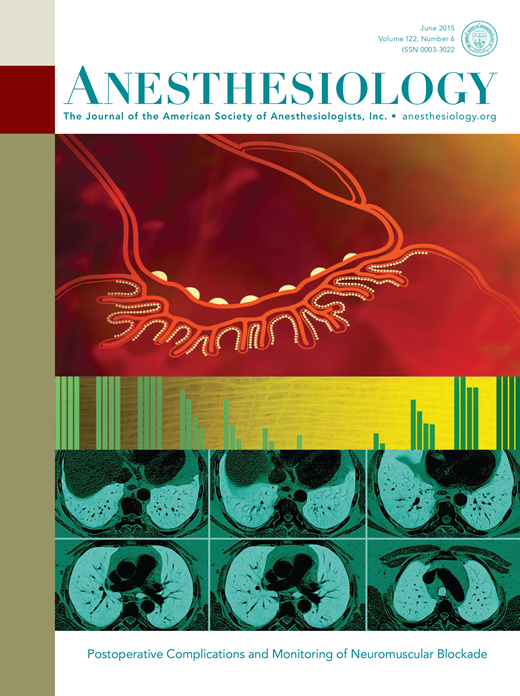Recovery of the acute hypoxic ventilatory response after reversal of a minimal neuromuscular block. A randomized, controlled trial in healthy, non-obese volunteers.
IF 9.1
1区 医学
Q1 ANESTHESIOLOGY
引用次数: 0
Abstract
BACKGROUND Neuromuscular blocking agents inhibit the peripheral chemoreflex. We examined the effect of sugammadex 2 mg/kg and 4 mg/kg compared to spontaneous recovery of neuromuscular block (NMB) on the recovery of the acute hypoxic ventilatory response (AHVR). METHODS This was a 2-experiment, randomized, controlled trial in healthy volunteers. Participants received a continuous infusion of rocuronium, to achieve stable symptoms of neuromuscular block in the head and neck region (symptomatic NMB). Thereafter, NMB was allowed to recover spontaneously in the first experiment, while in experiment 2, volunteers were randomized to receive sugammadex 2 mg/kg or 4 mg/kg for reversal. The depth of neuromuscular block was assessed with electromyography at the adductor pollicis muscle. AHVR was measured at baseline; during stable NMB; and at 0-, 20-, and 40-minutes post-recovery. RESULTS Thirty-seven volunteers were enrolled; data from 27 volunteers were eligible for analysis. AHVR was reduced by 32% (mean difference versus baseline (MD) -0.22 L.%-1.min-1, 95% CI -0.32 to -0.12) during symptomatic NMB (mean train of four ratio 0.42 ± 0.22;). At the disappearance of all symptoms, AHVR remained on average depressed by 23% (MD -0.16 L.%-1.min-1, 95% CI -0.28 to -0.04). In 57% of volunteers following spontaneous recovery versus 28% following sugammadex reversal, AHVR did not return to baseline values during the measurement period. In addition, the magnitude of residual AHVR depression was greater following spontaneous recovery compared to reversal with sugammadex. However, on average AHVR was not significantly different from baseline at 20 and 40 minutes post-recovery in any group. CONCLUSIONS The AHVR after reversal of a minimal NMB with sugammadex did not significantly differ with spontaneous recovery of NMB. However, fewer patients had residual depression of AHVR when sugammadex was used. In all groups, a considerable proportion of patients had residual depression of the AHVR 40 minutes after recovery.最小神经肌肉阻滞逆转后急性缺氧通气反应的恢复。一项针对健康非肥胖志愿者的随机对照试验。
背景:神经肌肉阻滞剂抑制外周化学反射。我们比较了糖madex 2 mg/kg和4 mg/kg与神经肌肉阻滞自发恢复(NMB)对急性缺氧通气反应(AHVR)恢复的影响。方法采用2个试验,随机对照,健康志愿者。参与者接受持续输注罗库溴铵,以达到头颈部神经肌肉阻滞的稳定症状(症状性NMB)。之后,在第一个实验中,让NMB自发恢复,而在实验2中,志愿者随机接受2 mg/kg或4 mg/kg的糖胺酮进行逆转。在拇内收肌处用肌电图评估神经肌肉阻滞深度。基线时测量AHVR;稳定NMB期间;在恢复后0、20和40分钟。结果共纳入37名志愿者;来自27名志愿者的数据符合分析条件。AHVR降低32%(平均差异与基线(MD) -0.22 l %-1)。min-1, 95% CI -0.32 ~ -0.12)(四组平均比值0.42±0.22;)。在所有症状消失后,AHVR平均抑郁率为23% (MD -0.16 L.%-1)。min-1, 95% CI -0.28 ~ -0.04)。在57%的自发恢复志愿者和28%的糖madex逆转志愿者中,AHVR在测量期间没有恢复到基线值。此外,自发性恢复后残留的AHVR抑郁程度比使用糖madex逆转后更大。然而,任何组在恢复后20和40分钟的平均AHVR与基线没有显著差异。结论糖爽逆转最小NMB后的AHVR与NMB自发恢复无显著差异。然而,使用糖麦德后,AHVR患者出现残留抑郁的患者较少。在所有组中,相当比例的患者在康复后40分钟仍有AHVR残留抑郁。
本文章由计算机程序翻译,如有差异,请以英文原文为准。
求助全文
约1分钟内获得全文
求助全文
来源期刊

Anesthesiology
医学-麻醉学
CiteScore
10.40
自引率
5.70%
发文量
542
审稿时长
3-6 weeks
期刊介绍:
With its establishment in 1940, Anesthesiology has emerged as a prominent leader in the field of anesthesiology, encompassing perioperative, critical care, and pain medicine. As the esteemed journal of the American Society of Anesthesiologists, Anesthesiology operates independently with full editorial freedom. Its distinguished Editorial Board, comprising renowned professionals from across the globe, drives the advancement of the specialty by presenting innovative research through immediate open access to select articles and granting free access to all published articles after a six-month period. Furthermore, Anesthesiology actively promotes groundbreaking studies through an influential press release program. The journal's unwavering commitment lies in the dissemination of exemplary work that enhances clinical practice and revolutionizes the practice of medicine within our discipline.
 求助内容:
求助内容: 应助结果提醒方式:
应助结果提醒方式:


